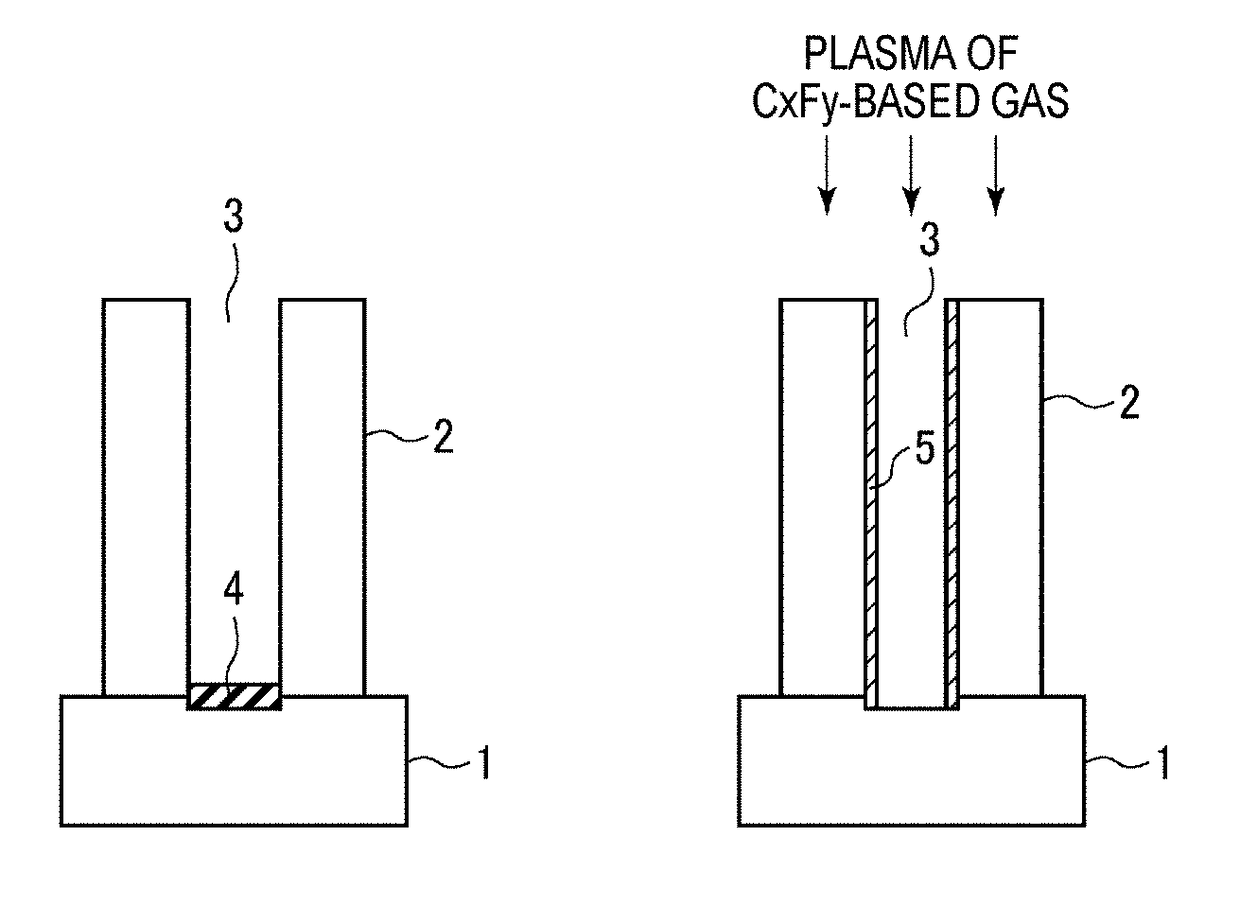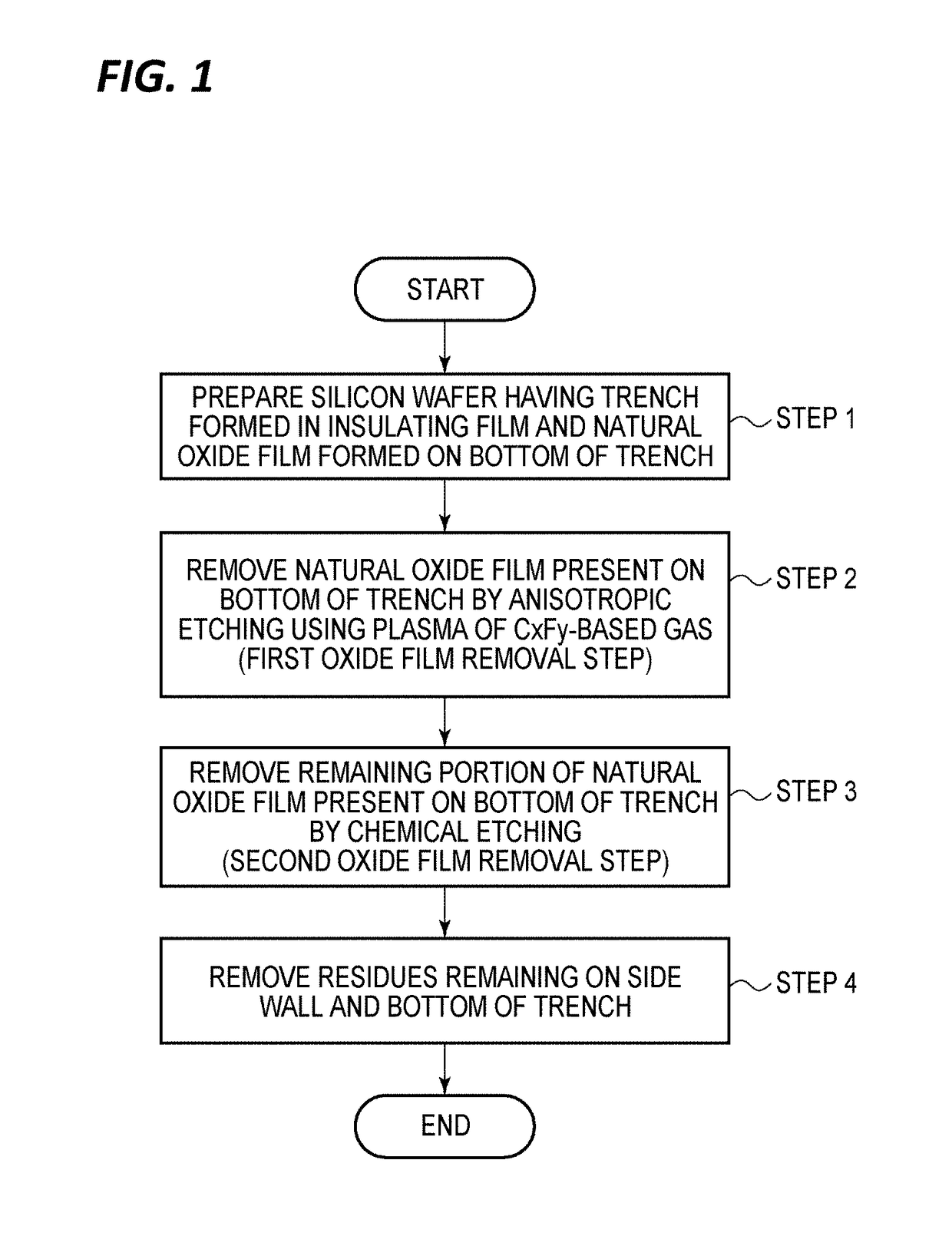Oxide film removing method, oxide film removing apparatus, contact forming method, and contact forming system
- Summary
- Abstract
- Description
- Claims
- Application Information
AI Technical Summary
Benefits of technology
Problems solved by technology
Method used
Image
Examples
first exemplary embodiment
[0074][Oxide Film Removing Method]
[0075]First, an oxide film removing method according to a first exemplary embodiment will be described.
[0076]FIG. 1 is a flowchart illustrating an oxide film removing method according to a first exemplary embodiment. FIGS. 2A to 2D are sectional views illustrating the oxide film removing method step by step.
[0077]In the exemplary embodiment, descriptions will be made on a case of removing a natural oxide film formed on the surface of a silicon portion of the bottom of a trench formed as a predetermined pattern in a workpiece before forming a contact by depositing a contact metal on the silicon portion.
[0078]First, a processing target substrate (silicon wafer) having an insulating film 2 formed on a silicon base 1 and a trench 3 formed as a predetermined pattern in the insulating film 2 is prepared (step 1; FIG. 2A). A natural oxide film (silicon-containing oxide film) 4 is formed on the silicon portion of the bottom of the trench 3. The insulating f...
second exemplary embodiment
[0155]Next, an oxide film removing method according to a second exemplary embodiment will be described.
[0156]FIG. 11 is a flowchart illustrating an oxide film removing method according to a second exemplary embodiment. FIGS. 12A to 12D are sectional views illustrating the oxide film removing method step by step.
[0157]Also in the exemplary embodiment, descriptions will be made on a case of removing a natural oxide film formed on the surface of a silicon portion of the bottom of a trench formed as a predetermined pattern in a workpiece before forming a contact by depositing a contact metal on the silicon portion.
[0158]First, a processing target substrate (silicon wafer) having an insulating film 2 formed on a silicon base 1 and a trench 3 formed as a predetermined pattern in the insulating film 2 is prepared (step 21; FIG. 12A). A natural oxide film (silicon-containing oxide film) 4 is formed on the silicon portion on the bottom of the trench 3. The insulating film 2 is mainly made of...
third exemplary embodiment
[0198]Next, an oxide film removing method according to a third exemplary embodiment will be described.
[0199]FIG. 21 is a flowchart illustrating an oxide film removing method according to a third exemplary embodiment. FIGS. 22A to 22C are sectional views illustrating the oxide film removing method step by step.
[0200]Also in the exemplary embodiment, descriptions will be made on a case of removing a natural oxide film formed on the surface of a silicon portion of the bottom of a trench formed as a predetermined pattern in a workpiece before forming a contact by depositing a contact metal on the silicon portion.
[0201]First, a processing target substrate (silicon wafer) having an insulating film 2 formed on a silicon base 1 and a trench 3 formed as a predetermined pattern in the insulating film 2 is prepared (step 31; FIG. 22A). A natural oxide film (silicon-containing oxide film) 4 is formed on the silicon portion on the bottom of the trench 3. The insulating film 2 is mainly made of a...
PUM
 Login to View More
Login to View More Abstract
Description
Claims
Application Information
 Login to View More
Login to View More - R&D
- Intellectual Property
- Life Sciences
- Materials
- Tech Scout
- Unparalleled Data Quality
- Higher Quality Content
- 60% Fewer Hallucinations
Browse by: Latest US Patents, China's latest patents, Technical Efficacy Thesaurus, Application Domain, Technology Topic, Popular Technical Reports.
© 2025 PatSnap. All rights reserved.Legal|Privacy policy|Modern Slavery Act Transparency Statement|Sitemap|About US| Contact US: help@patsnap.com



